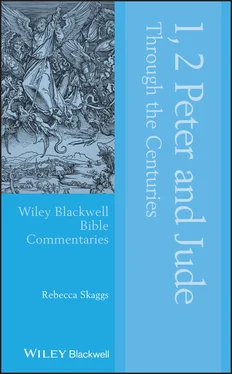To ask joy of this sort is not to plead only with your words for entry into the heavenly fatherland but also to strive with labor to receive it. ( Homilies on the Gospels 2:12, HOG 2:111)
Luther conveys some of the nature of the joy promised:
An unspeakably glorious joy shall that be, – and there is scarcely so clear a passage on the subject of the future joy as the one in this place, – and still he finds himself unable to express it. (Luther, Comm .: ccel.org)
After the time of the Reformation, writers and pastors were also interested in the relation of suffering and joy. For example, Matthew Poole (1624–1679) reads 1 Peter 1:6–8 in terms of grief and joy, but explains that a person can experience both “heaviness” or grief at the same time as joy by realizing that the grief is in the present while rejoicing is coming in the future: “they might grieve as men but rejoice as saints … suffering might affect them but the faith of better things coming will relieve them” (1669: 900).
Thomas Vincent (1634–1678) was also an English Puritan minister and author. Having graduated from Oxford, he ministered in London during the plague and fire of 1665–1666, during which seven members of his own family perished. He used this passage (vv.6–8) in a practical way to comfort the sufferers of this terrible time in London. In fact, he published a beautiful devotional on 1 Peter 1:8, The True Christian’s Love for the Unseen Christ , in which he exhorts Christians to “promote the decaying love of Christ” in their hearts (1812: 6: ccel.org). Vincent sets Peter’s message of comfort within the framework of the love of Christ by emphasizing the comfort which comes only from the experience of Christ’s presence in the suffering, along with the hope of future glory, love, and joy. For example, he powerfully yet poetically expresses: “O the future glorious light which there and then will shine into every corner of my mind! … this, this only will make you willing to die, and this sense of Christ’s love will effectually sweeten your passage through the dark entry of death” (1812: 172: ccel.org).
About the same time, Thomas Watson (1620–1686), another English nonconformist, Puritan preacher and author also used Peter’s message of love and suffering. In his sermon “The Perfume of Love” on 1 Peter 1:22 he interweaves Peter’s message on love with both Paul (1 Cor. 13) and the Gospel of John to encourage and exhort Christians to “arm themselves with love” in order to confront suffering with a pure heart ( The Thomas Watson Reading Room , Sermon: “The Perfume of Love”: preceptaustin.org).
Modern scholars debate whether the term should be read as an imperative (a command to the readers to rejoice) or an indicative (descriptive with a future meaning). The present indicative conveys “confident assertions about the present,” particularly prophecies, which can stand for the future (for the meaning of this grammatical construction, see Blass and Debrunner, 1961: sec. 323; for a current perspective, see Martin, 1992). This suggests that the joy will certainly take place after they have suffered for a little while. Hence, for Peter, suffering produces current joy, but more importantly, “inexpressible, glorious joy” in the future.
Some writers are particularly interested in an existential sense of joy. For example, Kierkegaard is intrigued by Peter’s concept of “inexpressible joy” in 1:7. As usual, he views it through the lens of paradox and existence:
he calls the joy unutterable – But suppose the inexpressible joy had its ground in the contradiction that an existing human being is a synthesis of the infinite and the finite situated in time, so that the joy of the eternal in him becomes inexpressible because he is an existing individual, becomes a highest breath of the spirit which is nevertheless incapable of finding embodiment, because the existing individual exists: then the explanation would be that it is unutterable, that it cannot be otherwise; no nonsense please. ( Concluding Unscientific Postscript , 1968: 198)
This passage (1:3–9) has been used for centuries and is still being used in the Easter liturgies of the main religious groups, such as the Roman Catholic, Episcopal, Lutheran, and United Methodist Churches, to express the future hope and joy of salvation ( Choral Literature for Sundays and Seasons; also see the Revised Common Lectionary ).
The “unspeakable” or inexpressible joy of v.8 has been memorialized in song, for example, “Joy Unspeakable and Full of Glory” by Barney E. Warren, published in 1900, captures the spirit of joy expressed in these verses. In 2012, “Joy Unspeakable and Full of Glory” is used as the title of a book detailing the life and ministry of the young eighteenth‐century pastor Samuel Pearce and his wife Sarah ( Classics of Reformed Spirituality ). Their lives express the sense of this passage: although he died at 33 years old, his biographer remarks that according to many of his contemporaries he “condensed a lifetime of holy and joyful ministry into a single decade” (back cover of the book, amazon.com).
(Refrain) It is joy unspeakable and full of glory,
Full of glory, full of glory,
It is joy unspeakable and full of glory,
Oh, the half has never yet been told.
I have found His grace is all complete,
He supplieth ev’ry need;
While I sit and learn at Jesus’ feet,
I am free, yes, free indeed.
I have found the pleasure I once craved,
It is joy and peace within;
What a wondrous blessing! I am saved
From the awful gulf of sin.
I have found that hope so bright and clear,
Living in the realm of grace;
Oh, the Savior’s presence is so near,
I can see His smiling face.
I have found the joy no tongue can tell,
How its waves of glory roll!
It is like a great o’erflowing well,
Springing up within my soul.
I’ve found a Savior dear to me,
More precious than gold;
He saved my soul and made me free,
There’s joy in my soul!
( cyberhymnal.org)
Consequences of the Transformed Life: Suffering Related to the Suffering of Christ (1:11–12)
Overview
Here, Peter sets his argument on suffering into a larger context: the trials his readers are experiencing are not random or unintentional on God’s part. They are directly connected to the suffering and glory of Christ himself, foretold by the prophets. Most likely, these are Jewish figures (including apocalyptic ones) as well as Christian ones in the church at the time. For Peter, the salient point is that they “made diligent and careful inquiry” into these things. These two words are linked in Ps. 118[119]:2, LXX, and convey the sense of “searching out” the testimonies of the Lord and “seeking out” the Lord himself (Michaels, 1988: 40). Peter is emphasizing the devotional intensity with which the prophets pursued knowledge and understanding of God’s promised plan, as revealed by the “Spirit of Christ.” According to Peter, this revelation has to do with the sufferings and ultimate glorification of Christ. Even though the prophets knew they would not see the fulfillment of these promises, they ardently sought to understand them.
In our author’s time, many of these promises had already taken place, but more is to come. There is the “grace to be given you when at the end of time Jesus Christ is revealed” (vv.11, 13). This grace goes beyond the salvation they experience in the present. Both terms (“salvation” sought by the prophets and the “grace” yet to come) are in a similar grammatical construction, with the preposition peri, indicating that they are to be taken together. Assuredly, Peter expects the final revelation of Christ to be in an eschatological context (vv.5, 9). The mysterious nature of this revelation is further highlighted in that, while the prophets intensely searched to understand it, the angels themselves “long to look into these things” (v.12).
Читать дальше












